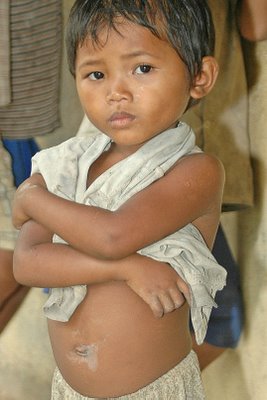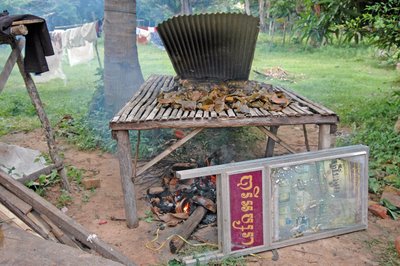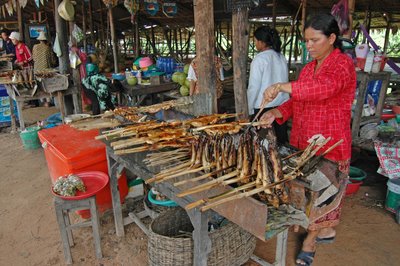Hi folks!
Bought a car. Yep, we bought a car. I wanted a motorcycle, because it is so easy to get around on a motorcycle. You zip here and zip there. But that is seen precisely as the problem–you can zip right into something. The car we bought is an old Corolla, older than the Corolla that we used to have in Virginia. The air conditioner works, which is important here. The motor runs, which is always helpful. The tires are good. Four of the five seatbelts work. We could even drive to Phnom Penh if we wanted to, but then we would have to drive in Phnom Penh, which is much worse than driving here. I can’t imagine driving in Phnom Penh; it would be suicidal. Every traffic law in the world, including the three on the books in Cambodia, are willfully ignored in Phnom Penh. The three laws in Cambodia are 1) stop when asked to by signs or lights; 2) drive on your own side of the road, Dummy; and 3) you get no points for hitting grandmothers.
I will still be riding motorcycles, or motos, as we call them, from time to time. They are Hondas that the Capacity Building Program bought used. That’s how we tend to get out in the country, given the state of the roads here, and the Program needs to get to the health centers and villages. Moreover, as we add two new health centers to work with each year, we are reaching farther out in the province. Last week, the two dramatic performances I mentioned in the last posting were delivered some 50 or 55 kilometers from home. Even four-wheel drive vehicles can’t go where motos can go, or if they can, they do it more slowly. For that matter, four-wheel drive vehicles on some of the country roads around here get passed by bicycles, which even village matrons can pedal quietly around deep potholes without missing a beat.
To get to the first day's performance, I rode on the back of a moto, holding on for dear life. There’s something more scary about sitting on the back, having no control, being largely unable to see around the driver, than about driving your own moto. So for two hours I gripped the bars underneath the seat thinking that would protect me. Even if we didn’t hit anything, the bumps throw you up in the air and you wonder where the moto will be when you come down. The second day, I rode out in a small bus and rode back in the four-wheel drive. The bus is not a normal part of our vehicular repertoire and the four-wheel drive is not always available, so I have been told to expect to drive a moto in the future when we go out to the villages.
This coming Wednesday I will drive to work for the first time in our new car. Tomorrow, Monday, is a holiday. Actually today, Sunday, is the holiday; it’s the anniversary of the present king’s accession to the throne (King Sihamoni). But the holiday is observed tomorrow. Tuesday is also a holiday. It is the birthday of the previous king, King Sihanouk. So on Wednesday I will drive to work. My guess is that by fighting my way skillfully through traffic I will get there in six or seven minutes. If I were going to the Angkor Hospital for Children, it would take only five minutes. But I go over to the Wat Damnak area now–you all know it: cross the Siem Reap River, take a right past Wat Damnak, turn left down a dirt road to what we call the "White House." That’s where the Capacity Building Program works. We don’t spend our money on frills.
I am actually writing this posting before sending the previous posting, which I hope to send to you tomorrow morning if possible. (Yes, I’ll be working on a holiday.) If I manage to do that, those of you who live in America will receive it today, Sunday. That’s why we will outlive you, having gone west to get east. We do things before you even think of them. We are always in the vanguard. If you remember, we discussed this issue in an earlier posting.
I wanted to get this new posting going so that I can send you some pictures of the performances that I have been telling you about. The two messages of this performance were tuberculosis and childhood vaccinations. We limit the messages to two at a time because it is easier to remember only two. (I say "we" limit, but of course I don’t limit anything. I just work here, trying to help them with administrative stuff. All these decisions are made by people who have experience in these kinds of things. If I were the audience, they would have to limit the message to one, or perhaps not even bother.)
These two performances were both given in the morning, which meant that most adults were working in the fields and couldn’t come, so our audience consisted mostly of rapt children. Putting shows on in the evening can be complicated, though, both for the audience and for us, but we want to try it soon.
The first show was delivered from a concrete stage in the middle of a field across the road from a school. The only shade came from the roof over the stage and from a large tree about thirty meters from the stage and to the right. The audience stayed in the shade. Fortunately, the tree shade fell to the left, bringing them roughly in front of the stage rather than farther to the right, where they would have stayed relatively cool but missed the show. As the sun moved over the horizon during the course of the morning, the shade moved, and so did the people. Every time I looked, the audience had shifted to cover a different patch of ground. The second performance took place in a large meeting hall with a roof overhead in a pagoda. This allowed the entire audience to sit under the roof and watch the performance.
The performances include skits that give messages and other skits that are just funny. The performance started with the voice of a giant coming from backstage. It was a low pitched, guttural voice–loud, commanding. He came frontstage, continuing to talk in this low growl.

Note the shoes and the microphone. All the actors carried a wireless microphone, but only the giant wore athletic shoes. I don’t know if that was deliberate or if that’s just how he felt comfortable. The story line in this skit, I was told, was that a mere germ, so small that you can’t see it, can’t possibly bring down a giant, but of course this giant started getting a cough. The writing and symbol behind him on the curtain announce that the show is presented by the Capacity Building Program.
The performance was accompanied by three musicians, one on a single-stringed instrument played with a bow, one on drums, and one on a kind of xylophone.

The man with the stringed instrument, whom I will call the fiddler, played during most of the performance; the drums and xylophone joined in during transitions between skits. I took another picture of the fiddler by himself and noticed his foot and the television that sat facing the players, not facing the audience.

What was the TV for? Well, later they played karaoke on the TV. The audience couldn't see the TV but they could hear the music. An actor could see the TV and sing the words that appeared at the bottom of the screen. All the power for the sound system and the TV was supplied by a generator that we brought along.
I figured the fiddler was likely to have another foot and wondered where it was. I went around to his side of the stage and got a peek between the TV next to him and the curtain and rail behind him. Here it is:

Notice the rapt audience:


By the way, I want to develop within you a Pavlovian response to pictures of children such as these, so that when you see pictures of Cambodian children you can’t help but think must...write...check, and you will grab your checkbook and write a check to FWAB. With each check, you help fund both the Angkor Hospital for Children and the Capacity Building and Health Education Program. How can you beat that? (Yes, Uncle Gaylord, in the U.S. you get a tax deduction.) For more information, just click here:
http://www.fwab.org/Pages/donations.htm
Another skit dealt with childhood immunizations and why they are critical to the child’s health. Here are two young women carrying their babies discussing the recommended schedule of vaccinations and pointing out that vaccinations are available at the health center.

 There were silly skits:
There were silly skits:
 There was poignant drama:
There was poignant drama:
 There was song:
There was song: One of the last skits was a boxing match:
One of the last skits was a boxing match:

 The rest of the pictures may gross some of you out. You may decide when you get to the end of this paragraph that you don’t want to see them. Near the end of the first performance, some of the actors who had no more roles to play started cooking lunch for the whole group. I had earlier seen a large frog that someone had captured. They tied a long ribbon around the frog’s leg so he could hop around but couldn’t escape. I had not, however, seen a plastic bag full of live frogs, shown in the first picture here. The man standing on the left is taking out one frog after another and cutting off the head against a tree (second picture) with a machete. The head falls to the ground. (This is not shown clearly in the picture.) He throws the body into the pot of now bloody water (third picture), from which the boy and the two men take them out and pull off their skin, which is left on the ground. (Isn’t it nice to see a young boy learning a trade?) Then they break up the pieces of frog by hand (fourth picture) and place them in the large cooking pot (last picture), to which oil, greens, salt and other condiments are added to cook them. Gross? Think about how you get your chickens pieces or your sausage. The large captive frog escaped the pot. I don’t know whether he escaped from captivity.
The rest of the pictures may gross some of you out. You may decide when you get to the end of this paragraph that you don’t want to see them. Near the end of the first performance, some of the actors who had no more roles to play started cooking lunch for the whole group. I had earlier seen a large frog that someone had captured. They tied a long ribbon around the frog’s leg so he could hop around but couldn’t escape. I had not, however, seen a plastic bag full of live frogs, shown in the first picture here. The man standing on the left is taking out one frog after another and cutting off the head against a tree (second picture) with a machete. The head falls to the ground. (This is not shown clearly in the picture.) He throws the body into the pot of now bloody water (third picture), from which the boy and the two men take them out and pull off their skin, which is left on the ground. (Isn’t it nice to see a young boy learning a trade?) Then they break up the pieces of frog by hand (fourth picture) and place them in the large cooking pot (last picture), to which oil, greens, salt and other condiments are added to cook them. Gross? Think about how you get your chickens pieces or your sausage. The large captive frog escaped the pot. I don’t know whether he escaped from captivity.



 Gotta go. It’s lunch time.
Gotta go. It’s lunch time.
















